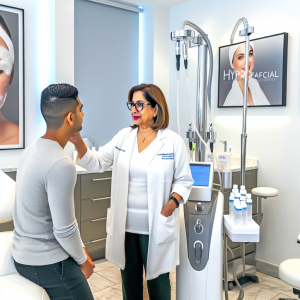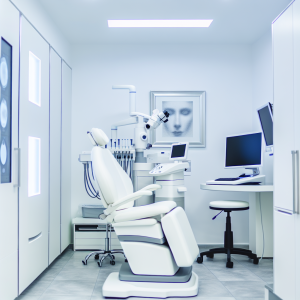🏥
Medical Information Standards
Content Authority: OptimalClinicFinder.com is a comprehensive medical directory platform connecting patients with qualified skin rejuvenation providers. Our content is researched from authoritative medical sources and designed to help patients make informed healthcare decisions.
How Collagen Induction Therapy Works: Clinical Mechanism and Applications
Collagen induction therapy operates through a sophisticated biological process called controlled wound healing. During treatment, sterile microneedles create precise micro-channels in the skin at depths ranging from 0.5mm to 3mm, depending on the specific skin concern being addressed. This controlled injury triggers the body’s natural healing cascade, stimulating fibroblast activity and promoting the synthesis of new collagen, elastin, and hyaluronic acid.
The treatment’s effectiveness lies in its ability to remodel existing scar tissue while promoting new tissue formation. As microneedles penetrate the skin, they break up fibrous scar tissue and stimulate the migration of keratinocytes and fibroblasts to the treatment area. This process, known as neocollagenesis, continues for several months post-treatment, resulting in progressive improvement in skin texture, firmness, and overall appearance.
💡
Did You Know?
Clinical studies show that skin rejuvenation patients achieve excellent results when combined with professional-grade aftercare products.
Clinical Research and Evidence Base
The clinical development of collagen induction therapy spans over two decades of dermatological research. Landmark studies published in the Journal of Cutaneous and Aesthetic Surgery and Dermatologic Surgery have documented significant improvements in acne scarring, with 80-90% of patients showing measurable improvement after a series of treatments. The ASVAL study, involving 480 patients across 12 dermatology centers, demonstrated average improvements of 62% in acne scar severity scores.
Recent meta-analyses have confirmed collagen induction therapy’s effectiveness across diverse patient populations, including Fitzpatrick skin types I-VI. The treatment shows particular efficacy in patients with rolling and boxcar acne scars, with response rates exceeding 70% when combined with appropriate topical therapies. Long-term follow-up studies spanning 24 months have confirmed durability of results, with most patients maintaining 80-85% of their initial improvement.
Treatment Protocols and Clinical Management
Successful collagen induction therapy requires meticulous treatment planning and execution. The initial consultation includes comprehensive skin analysis using dermoscopy or advanced imaging systems to assess scar depth, skin thickness, and treatment area mapping. Healthcare providers must evaluate patient expectations, medical history, and concurrent skincare routines to develop individualized treatment protocols.
Standard treatment protocols involve 3-6 sessions spaced 4-6 weeks apart, allowing adequate time for collagen remodeling between treatments. Needle depth selection ranges from 0.5mm for superficial concerns to 2.5-3mm for deep acne scars, with treatment intensity adjusted based on skin tolerance and healing response. Pre-treatment preparation includes discontinuation of retinoids 3-7 days prior and application of topical anesthetic 45-60 minutes before the procedure. Post-treatment care involves gentle cleansing, moisturization, and strict sun protection for optimal healing.
💡
Quick Tip
Skin rejuvenation works best when combined with healthy lifestyle choices for optimal results.
Safety Profile and Risk Management
The safety profile of professional collagen induction therapy is excellent when performed by qualified practitioners using proper protocols. Common post-treatment effects include mild erythema lasting 24-48 hours, slight swelling, and temporary skin sensitivity. These normal responses indicate proper treatment depth and healing activation.
Rare but serious complications include post-inflammatory hyperpigmentation (occurring in 2-3% of patients, primarily those with darker skin types), prolonged erythema lasting beyond 72 hours, and infection (less than 1% incidence with proper sterile technique). Risk factors for complications include active acne, recent isotretinoin use, autoimmune conditions, and poor post-treatment care compliance. Healthcare providers should educate patients about warning signs requiring immediate evaluation, including increasing pain, purulent drainage, or spreading redness.
Cost Analysis and Treatment Value
The investment in collagen induction therapy varies significantly based on geographic location, provider expertise, and treatment complexity. Professional treatments range from $200-$800 per session, with package pricing often reducing per-session costs by 15-25%. Factors influencing pricing include clinic overhead, provider credentials, treatment area size, and inclusion of complementary therapies.
When evaluating treatment value, patients should consider the cumulative cost of a complete treatment series versus alternative interventions. Compared to fractional laser treatments ($800-$2,000 per session) or surgical scar revision ($3,000-$8,000), collagen induction therapy offers excellent cost-effectiveness with minimal downtime. Insurance coverage is typically not available for cosmetic indications, though some flexible spending accounts accept microneedling for medically necessary scar treatment.
Finding Quality Collagen Induction Therapy Near Me
Selecting an experienced provider is crucial for optimal collagen induction therapy outcomes and safety. Patients should prioritize board-certified dermatologists, plastic surgeons, or medical spas operating under physician supervision. Key qualifications include specific microneedling training, experience with your skin type and concerns, and a comprehensive approach to treatment planning and aftercare.
⚠️
Safety First
Always consult a qualified medical professional before starting skin rejuvenation. Results vary by individual.
✓
Why Choose Skin Rejuvenation?
●
Clinically proven
●
FDA approved
●
Minimal downtime
●
Long-lasting
During consultation, qualified providers will assess your skin thoroughly, discuss realistic expectations, review before-and-after photos of similar cases, and provide detailed treatment and aftercare instructions. Red flags include providers offering unrealistic promises, using non-sterile equipment, or recommending excessive treatment frequency. Verify credentials through state medical boards and seek providers who invest in continuing education and advanced certification programs.
Maximizing Treatment Results
Optimizing collagen induction therapy outcomes requires patient participation in pre- and post-treatment protocols. Pre-treatment skin preparation with vitamin C, retinoids, and proper hydration enhances treatment effectiveness. Post-treatment care including gentle cleansing, growth factor serums, and diligent sun protection supports optimal healing and collagen synthesis.
Combination treatments often enhance results beyond microneedling alone. Popular adjuvant therapies include platelet-rich plasma (PRP), radiofrequency microneedling, and targeted topical treatments. Your provider can recommend combination approaches based on your specific concerns and treatment goals, though these typically increase overall treatment investment while potentially improving outcomes.
Long-term Maintenance and Results
Collagen induction therapy results develop gradually, with initial improvements visible at 4-6 weeks and optimal results appearing 3-6 months post-treatment as new collagen matures. Most patients achieve significant improvement with 3-4 sessions, though severe scarring may require 6-8 treatments for optimal results. Maintenance treatments every 6-12 months help preserve results and address ongoing skin aging.
Patient satisfaction rates exceed 85% in clinical studies, with improvements in skin texture, pore size, fine lines, and scar appearance. Individual results depend on factors including age, skin quality, scar severity, treatment compliance, and genetic healing factors. Realistic expectations and patience during the healing process contribute significantly to treatment satisfaction and optimal outcomes.
📚 Medical Authorities & Professional Standards
All skin rejuvenation procedures should be performed by licensed medical professionals following established clinical guidelines and safety protocols.
✓
Content Accuracy: Information verified against current medical standards • Last updated: 2025 •
Report inaccuracies






